Each year on July 25, urban and rural groups, progressives and conservatives, and people near and far all come together to celebrate the Colorado River. As the hardest working river in the West, it's up to us to work together to protect the future of the water- and while the river has seen some hard times, the future is looking bright. On this day in 1921, Congress voted to change the name of the river from "Grand" to "Colorado." But while the name change doesn't necessarily affect the river, many other changes have. As the West had continued to expand, the river serves as an economic engine for the entire country. The river supports 16 million jobs, generates $1.4 trillion in economic benefits, and supplies drinking water for 38 million people across seven states and two countries.
Apart from the economic benefits, the river supports an abundance of recreational activities. The river is home to 30 native fish species, two-thirds of which are threatened or endangered, and over 350 bird species.
 The mighty river also irrigates more than 1.8 million acres of land- producing about 15 percent of the nation’s crops and about 13 percent of livestock. These totals generate about $1.5 billion a year in agricultural benefits.
The mighty river also irrigates more than 1.8 million acres of land- producing about 15 percent of the nation’s crops and about 13 percent of livestock. These totals generate about $1.5 billion a year in agricultural benefits.
It's easy to see how the river may be overused and while it still faces serious hardships, some say the best days of the Colorado River are right now.
In the headwaters of the Colorado, a Learning by Doing initiative is underway to ensure that the health of the river and it's tributaries remain at the forefront even with additional diversion structures. Through Learning by Doing, the water is constantly monitored for temperature, riparian vegetation, and aquatic macro-invertebrates. If there is a problem detected, the appropriate measures will be implemented to make sure the water quality and trout habitat is preserved.
“The so-called “Learning by Doing” program sets up a collaborative process that requires water users to monitor the health of the river in coming years and adjust operations to address unforeseen challenges and opportunities," said David Nickum, Executive Director of Colorado Trout Unlimited.
 Another project in place to keep the Colorado River healthy is the Windy Gap Bypass. Issues with the reservoir's placement have put a stretch of river between Granby and Kremmling is jeopardy. But steps are being taken to bring the river back to health. A plan to bypass the reservoir and reconnect the river's natural flow is underway. “We wouldn’t be at this point without the leadership of Grand County and their persistent efforts to improve the health of the Colorado River,” said Kirk Klancke, president of TU’s Colorado River Headwaters chapter. “And the Northern subdistrict also deserves credit for listening to our concerns and working with all stakeholders to find solutions.”
Another project in place to keep the Colorado River healthy is the Windy Gap Bypass. Issues with the reservoir's placement have put a stretch of river between Granby and Kremmling is jeopardy. But steps are being taken to bring the river back to health. A plan to bypass the reservoir and reconnect the river's natural flow is underway. “We wouldn’t be at this point without the leadership of Grand County and their persistent efforts to improve the health of the Colorado River,” said Kirk Klancke, president of TU’s Colorado River Headwaters chapter. “And the Northern subdistrict also deserves credit for listening to our concerns and working with all stakeholders to find solutions.”
The river also saw a major victory when the Colorado Department of Public Health released a final 401 permit that affirms the health of the Colorado through the Windy Gap Firming Project. “This long-term monitoring and flexibility of response use is called ‘adaptive management’—and it’s a critical feature of the permit requirements,” said Mely Whiting, counsel for Trout Unlimited. “Adaptive management recognizes that stakeholders can’t foresee every problem, and it provides a process for ongoing monitoring and mitigation of river problems as they arise.”
 While further on down from the headwaters, Trout Unlimited is teaming up with ranchers and cattlemen to use water more efficiently and responsibly. "Continued development of the reservoir storage system is necessary, too, but ranchers need to realize their role and the opportunities they have to manage their water in a way that protects agricultures’s viability," said T. Wright Dickinson, former president of the Colorado Cattlemen’s Association.
While further on down from the headwaters, Trout Unlimited is teaming up with ranchers and cattlemen to use water more efficiently and responsibly. "Continued development of the reservoir storage system is necessary, too, but ranchers need to realize their role and the opportunities they have to manage their water in a way that protects agricultures’s viability," said T. Wright Dickinson, former president of the Colorado Cattlemen’s Association.
Down river, more awareness is being spread about safe water usage in dessert climates like Nevada and Arizona. And thanks to strong El Nino winter, a lot of California reservoirs were full this spring for the first time in years.
While the river provides life the west, the west is starting to supply like to the river. Through projects at the headwaters down to where the Colorado meets the Pacific, steps are being taken to ensure that the health of the river remains at the forefront for everybody who calls the west home.






 Mely Whiting, lead negotiator for Trout Unlimited:
Mely Whiting, lead negotiator for Trout Unlimited:
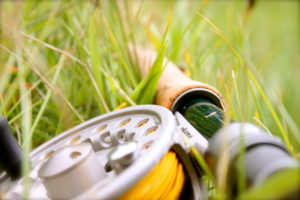
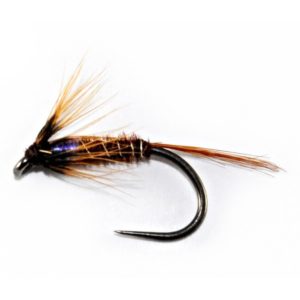
 Thus it is best to keep a fish in the water as much as possible, with a photo being taken swiftly- holding the fish only a few inches above the water.
Thus it is best to keep a fish in the water as much as possible, with a photo being taken swiftly- holding the fish only a few inches above the water.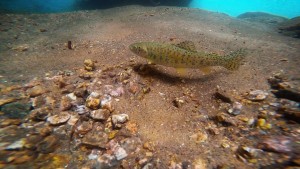 that would weaken the temperature standards that are supposed to protect trout streams throughout the state. The proposed changes brought forth by the Water Quality Control Division (WQCD) would put many trout fisheries at risk including during spawning periods.
that would weaken the temperature standards that are supposed to protect trout streams throughout the state. The proposed changes brought forth by the Water Quality Control Division (WQCD) would put many trout fisheries at risk including during spawning periods.
 Trout Unlimited is working to ensure that the temperatures of Colorado's streams remain at a healthy level for trout to survive. CTU has put together an
Trout Unlimited is working to ensure that the temperatures of Colorado's streams remain at a healthy level for trout to survive. CTU has put together an  As the flows of the river are diverted and reduced, the water temperature could rise to a level threatening to trout and aquatic life- but with the 401 permit, these conditions will be monitored to ensure the fishery remains Gold. Also with lower flowers, the sediment and algae buildup cements between the cobblestone, preventing invertebrates to hatch and trout to spawn. By providing these flushing flows the sediment will be washed away and leave the cobblestone clear for aquatic habitat to survive.
As the flows of the river are diverted and reduced, the water temperature could rise to a level threatening to trout and aquatic life- but with the 401 permit, these conditions will be monitored to ensure the fishery remains Gold. Also with lower flowers, the sediment and algae buildup cements between the cobblestone, preventing invertebrates to hatch and trout to spawn. By providing these flushing flows the sediment will be washed away and leave the cobblestone clear for aquatic habitat to survive.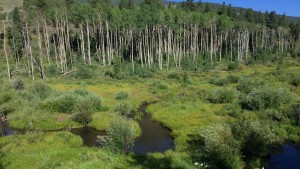
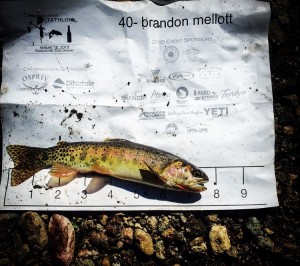 The rules remain very uncomplicated, yet yield the best outcomes to those who are the most avid strategists. Complete the prescribed trail run, catch a fish at any point during the run, take a picture of said fish on your race bib, and do it all as quickly as possible. The bigger the fish, the more time is taken off at the end of your run- with a special double bonus for catching a native cutthroat trout.
The rules remain very uncomplicated, yet yield the best outcomes to those who are the most avid strategists. Complete the prescribed trail run, catch a fish at any point during the run, take a picture of said fish on your race bib, and do it all as quickly as possible. The bigger the fish, the more time is taken off at the end of your run- with a special double bonus for catching a native cutthroat trout.




